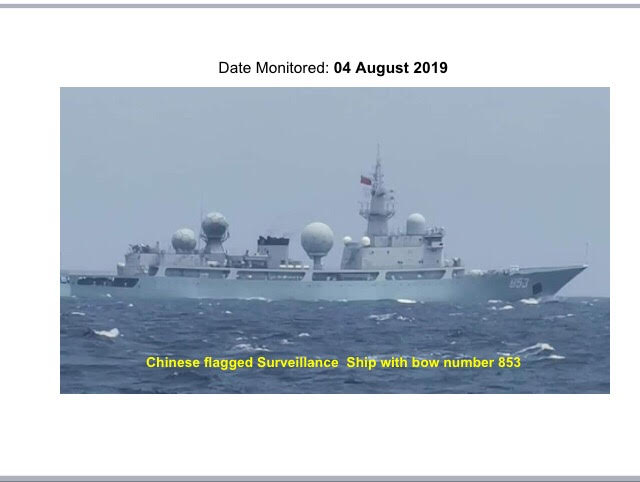How China’s failure to observe rules in PH waters clashes with own policy

Chinese-flagged surveillance ship with Bow No. 853 (Photo from Western Mindanao Command)
MANILA, Philippines — China’s series of failures to observe protocol while passing through Philippine waters clashes with its policy in its own waters and clearly highlights “double standard,” a maritime expert underscored Thursday.
Jay Batongbacal, director of the University of the Philippines Institute for Maritime Affairs and Law of the Sea, said China requires foreign warships to notify and seek for consent when entering its territorial waters, the very demand that it denies to the Philippines when passing through its waters.
“The entry of Chinese warships into Philippine waters without prior notice and consent of the Philippines runs counter to their own policy for their own waters, and thus demonstrates a double standard at the very outset,” he said in a Facebook post.
The military on Wednesday revealed fresh incidents of unannounced passage of five Chinese warships in Sibutu Strait in July and August. This comes after the Philippine government recently protested the passage of Chinese warships in Sibutu Strait from February to June.
Sibutu Strait is an international waterway located near Tawi-Tawi that is within the Philippines’ archipelagic and territorial waters. Foreign commercial ships have the right of innocent passage when passing through the country’s territorial waters, while foreign warships should at least inform Philippine authorities beforehand.
Article continues after this advertisement“The Philippines position, historically, has been that warships should at least provide notification prior to entering the Philippine territorial sea/inter-island waters,” Batongbacal said.
Article continues after this advertisement“The Philippines is entitled to enact rules and regulations governing passage through the territorial sea for purposes of maritime safety and management of marine traffic, including prescribing the use of sea lanes and traffic separation schemes,” he added.
China’s actions of passing through “without even acknowledging the Philippine queries, therefore, runs counter to the Philippines’ legitimate maritime safety regulations,” according to Batongbacal.
Armed Forces spokesperson Brig. Gen. Edgard Arevalo said China’s actions could be somehow likened to “trespassing.”
“Parang bakuran lang ‘yan ng ating tahanan (It’s like a backyard in our own house), kung kailangan ng makikiraan sa may-ari ng bahay dapat magpaalam (when someone needs to pass through, a permission must be sought from the owner). That’s the same requirement that we ask for them in order to obtain diplomatic clearance. Since they did not ask for clearance, these are incursions or trespassing in our territorial waters,” he said in a press briefing Thursday.
High-tech spy ship spotted
The most recent Chinese vessel to pass through the country’s territorial waters without informing Philippine authorities was Tianwangxing (853), a Dongdiao-class auxiliary general intelligence (AGI) ship with sophisticated capabilities. It was photographed by the Western Mindanao Command in Sibutu Strait last August 4.
“While transiting through the area appears expedient for the route back to homeport, the idea of such a transit could be to use it as a means to gather any intelligence that’s of interest, even if not specifically aimed at any particular force or entity, hence could be opportunistic in nature,” Singapore-based security expert Collin Koh told INQUIRER.net.
The nearby Sulu Sea, which separates the southern Philippines from Borneo, is also strategic in nature and is frequented by foreign naval powers, which is likely why China has taken an interest.
“I believe generally the Chinese are keen to build up what we may call an ‘electronic order of battle’ (EOB) or basically enhance its electronic domain awareness of the area – knowing what foreign assets are operating there, the general geographical conditions, etc.,” Koh said.
The Philippines may expect that the same ship or its sister ships would pass again in the future, he said. “Such EOB or awareness takes time to build into a comprehensive database. One mission alone won’t suffice.”
For the Philippine military, they don’t know what the Chinese warships are really up to.
“They might be conducting surveillance, studies, or surveys, which is something that would need a process with which they have to undertake before they could perform such actions,” Arevalo said.
“It is a security threat that we need to address.” /kga
RELATED STORIES
‘Double standard’ raised in China aircraft carrier passage near Tawi-Tawi
For comprehensive coverage, in-depth analysis, visit our special page for West Philippine Sea updates. Stay informed with articles, videos, and expert opinions.